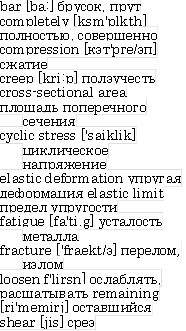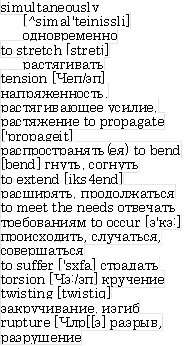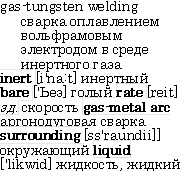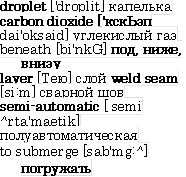сварка. How materials react to external forces
 Скачать 55.36 Kb. Скачать 55.36 Kb.
|
|
ТЕХТ HOW MATERIALS REACT TO EXTERNAL FORCES Materials Science and Technology is the study of materials and how they can be fabricated to meet the needs of modern technology. Using the laboratory techniques and knowledge of physics, chemistry, and metallurgy, scientists are finding new ways of using metals, plastics and other materials. Engineers must know how materials respond to external forces, such as tension, compression, torsion, bending, and shear. All materials respond to these forces by elastic deformation. That is, the materials return their original size and form when the external force disappears. The materials may also have permanent deformation or they may fracture. The results of external forces are creep and fatigue. Compression is a pressure causing a decrease in volume. When a material is subjected to a bending, shearing, or torsion (twisting) force, both tensile and compressive forces are simultaneously at work. When a metal bar is bent, one side of it is stretched and subjected to a tensional force, and the other side is compressed. Tension is a pulling force; for example, the force in a cable holding a weight. Under tension, a material usually stretches, returning to its original length if the force does not exceed the material’s elastic limit. Under larger tensions, the material does not return completely to its original condition, and under greater forces the material ruptures. Fatigue is the growth of cracks under stress. It occurs when a mechanical part is subjected to a repeated or cyclic stress, such as vibration. Even when the maximum stress never exceeds the elastic limit, failure of the material can occur even after a short time. No deformation is seen during fatigue, but small localised cracks develop and propagate through the material until the remaining cross-sectional area cannot support the maximum stress of the cyclic force. Knowledge of tensile stress, elastic limits, and the resistance of materials to creep and fatigue are of basic importance in engineering. Creep is a slow, permanent deformation that results from a steady force acting on a material. Materials at high temperatures usually suffer from this deformation. The gradual loosening of bolts and the deformation of components of machines and engines are all the examples of creep. In many cases the slow deformation stops because deformation eliminates the force causing the creep. Creep extended over a long time finally leads to the rupture of the material. . Answer the questions: 1. What are the external forces that cause the elastic deformation of materials? Describe those forces that change the form and size of materials. 2. What are the results of external forces? 3. What kinds of deformation are the combinations of tension and compression? 4. What is the result of tension? What happens if the elastic limit of material is exceeded under tension? 5. What do we call fatigue? When does it occur? What are the results of fatigue? 6. What do we call creep? When does this type of permanent deformation take place? What are the results of creep?   7.6. Find the following vcord combinations in the text: 1. отвечать требованиям современной технологии. 2. используя лабораторные методы. 3. новые способы использования металлов. 4. сжатие, растяжение, изгиб, кручение, срез. 5. возвращать первоначальный размер и форму. 6. внешняя сила. 7. постоянная деформация. 8. уменьшение объема. 9. растягивающие и сжимающие силы. 10. превышать предел упругости материала. 11. повторяющиеся циклические напряжения. 12. разрушение материала. 13. развитие и распространение мелких трещин. 14. сопротивление материалов ползучести и усталости. 7.7. Translate into English the following sentences: 1. Упругая деформация — это реакция всех материалов на внешние силы, такие, как растяжение, сжатие, скручивание, изгиб и срез. 2. Усталость и ползучесть материалов являются результатом внешних сил. 3. Внешние силы вызывают постоянную деформацию и разрушение материала. 4. Растягивающие и сжимающие силы работают одновременно, когда мы изгибаем или скручиваем материал. 5. Растяжение материала выше предела его упругости дает постоянную деформацию или разрушение TEXT 2 PROPERTIES OF MATERIALS Density (specific weight) is the amount of mass in a unit volume. It is measured in kilograms per cubic metre. The density of water is 1000 kg/m3 but most materials have a higher density and sink in water. Aluminium alloys, with typical densities around 2800 kg/m3 are considerably less dense than steels, which have typical densities around 7800 kg/m3. Density is important in any application where the material must not be heavy. Stiffness (rigidity) is a measure of the resistance to deformation such as stretching or bending. The Young modulus is a measure of the resistance to simple stretching or compression* It is the ratio of the applied force per unit area (stress) to the fractional elastic deformation (strain). Stiffness is important when a rigid structure is to be made. Strength is the force per unit area (stress) that a material can support without failing. The units are the same as those of stiffness, MM/m2, but in this case the deformation is irreversible. The yield strength is the stress at which a material first deforms plastically. For a metal the yield strength may be less than the fracture strength, which is the stress at which it breaks. Many t materials have a higher strength in compression than in tension. Ductility is the ability of a material to deform without breaking. One of the great advantages of metals is their ability to be formed into the shape that is needed, such as car body parts. Materials that are not ductile are brittle. Ductile materials can absorb energy by deformation but brittle materials cannot. Toughness is the resistance of a material to breaking ■when there is a crack in it. For a material of given toughness, the stress at which it will fail is inversely proportional to the square root of the size of the largest defect present. Toughness is different from strength; the toughest steels, for example, are different from the ones with highest tensile strengths Brittle materials have low toughness: glass can be broken along a chosen line by first scratching it with a diamond. Composites can be designed to have considerably greater toughness than their constituent materials. The example of a very tough composite is fiberglass that is very flexible and strong. Creep resistance is the resistance to a gradual permanent change of shape, and it becomes especially important at higher temperatures. A successful research has been made in materials for machine parts that operate at high temperatures and under high tensile forces without gradually extending, for example the parts of plane engines. ДОПОЛНИТЕЛЬНЫЙ СЛОВАРЬ; ability [a'biliti] способность absorb [sb'zo:b] поглощать amount [a'maunt] количество application [,aepli'keijsn] применение brittle ['britl] хрупкий, ломкий car body кузов автомобиля constituent [кэп' stitjuan t] компонент crack [kraek] трещина creep resistance устойчивость к ползучести definition [,defTniJan] определение density ['densiti] плотность ductility [dAk'tihti] ковкость, эластичность failure ['feiljs] повреждение, разрушение gradual f'grasdjual] постепенный rigid ['ri(%id] жесткий to sink [siqk] тонуть square root [ skwea'rud] квадратный корень stiffness ['stifnis] жесткость strain [strein] нагрузка, напряжение, деформация strength [strepG] прочность stress [stres] давление, напряжение tensile strength прочность на разрыв toughness ['tAfnis] прочность, стойкость yield strength [ji:ld] предел текучести Young modulus модуль Юнга 1.8. Answer the questions: 1. What is the density of a material? 2. What are the units of density? Where low density is needed? 3. What are the densities of water, aluminium and steel? 4. A measure of what properties is stiffness? When stiffness is important? 5. What is Young modulus? 6. What is strength? 7. What is yield strength? Why fracture strength is always greater than yield strength? 8. What is ductility? Give the examples of ductile materials. Give the examples of brittle materials. . What is toughness? What properties of steel are necessary for the manufacturing of: a) springs, b) car body parts, c) bolts and nuts, d) cutting tools? . Where is aluminium mostly used because of its light weight? 1.9. Find the following words and word combinations in the text: 1, количество массы в единице объема 2. тонна на кубический метр 3. мера сопротивления деформации 4. отношение приложенной силы на единицу площади к частичной упругой деформации 5. жесткая конструкция 6. прочность на сжатие 7. способность материала деформироваться не разрушаясь 8. поглощать энергию путем деформации 9. обратно пропорционально квадрату размера дефекта 10. постепенное изменение формы 11. повышенные температуры 12. высокие растягивающие усилия 7.10. Translate into English: 1. Плотность измеряется в килограммах на кубический метр. 2. Большинство материалов имеют более высокую плотность, чем вода и тонут в воде. 3. Плотность материала очень важна, особенно в авиации. 4. Модуль Юнга — отношение приложенной силы к упругой деформации данного материала. 5. Чем более металл жесткий, тем менее он деформируется под нагрузкой. 6. Когда металл растягивают, он сначала течет, то есть пластически деформируется. 7. Свинец, медь, алюминий и золото — самые ковкие металлы. 8. Сопротивление ползучести является очень важным свойством материалов, которые используются в авиационных моторах. WELDING Welding is a process when metal parts are joined together by the application of heat, pressure, or a combination of both. The processes of welding can be divided into two main groups: •pressure welding, when the weld is achieved by pressure and •heat welding, when the weld is achieved by heat. Heat welding is the most common welding process used today. Nowadays welding is used instead of bolting and riveting in the construction of many types of structures, including bridges, buildings, and ships. It is also a basic process in the manufacture of machinery and in the motor and aircraft industries. It is necessary almost in all productions where metals are used. The welding process depends greatly on the properties of the metals, the purpose of their application and the available equipment. Welding processes are classified according to the sources of heat and pressure used: gas welding, arc welding, and resistance welding. Other joining processes are laser welding, and electron-beam welding. Gas Welding Gas welding is a non-pressure process using heat from a gas flame. The flame is applied directly to the metal edges to be joined and simultaneously to a filler metal in the form of wire or rod, called the welding rod, which is melted to the joint. Gas welding has the advantage of using equipment that is portable and does not require an electric power source. The surfaces to be welded and the welding rod are coated with flux, a fusible material that shields the material from air, which would result in a defective weld. Arc Welding Arc-welding is the most important welding process for joining steels. It requires a continuous supply of either direct or alternating electrical current. This current is used to create an electric arc, which generates enough heat to melt metal and create a weld. Arc welding has several advantages over other welding methods. Arc welding is faster because the concentration of heat is high. Also, fluxes are not necessary in certain methods of arc welding. The most widely used arc-welding processes are shielded metal arc, gas-tungsten arc, gas- metal arc, and submerged arc. Resistance Welding In resistance welding, heat is obtained from the resistance of metal to the flow of an electric current. Electrodes are clamped on each side of the parts to be welded, the parts are subjected to great pressure, and a heavy current is applied for a short period of time. The point where the two metals touch creates resistance to the flow of current. This resistance causes heat, which melts the metals and creates the weld. Resistance welding is widely employed in many fields of sheet metal or wire manufacturing and is often used for welds made by automatic or semi-automatic [«semi «Ltq’mxtlk] machines especially in automobile industry. \/ ДОПОЛНИТЕЛЬНЫЙ СЛОВАРЬ: pressure welding сварка давлением heat welding сварка нагреванием instead [m'sted] вместо, взамен bolting ['boultip] скрепление болтами riveting ['rivitip] клепка basic ['beisik] основной to manufacture [^maenju'faekLj'a] изготовлять to depend [di'pend] зависеть от purpose ['parpas] цель gas welding газосварка arc welding электродуговая сварка resistance welding контактная сварка laser welding лазерная , сварка electron-beam welding электронно-лучевая сварка flame [fieim] пламя edge [ed^] край simultaneously [,sim3rtemi3sh] одновременно filler ['fib] наполнитель wire ['wais] проволока rod [rod] прут, стержень to melt [melt] плавить(ся) joint [dpint] соединение, стык coated ['koutid] покрытый 1. How can a process of welding be defined? 2. What are the two main groups of processes of weld- 3. How can we join metal parts together? 4. What is welding used for nowadays? 5. Where is welding necessary? 6. What do the welding processes of today include? 7. What are the principles of gas welding? 8. What kinds of welding can be used for joining steels? 9. What does arc welding require? 10. What is the difference between the arc welding and shielded-metal welding? Find the following words and word combinations in the text: 1. сварка давлением 2. тепловая сварка 3. болтовое (клепаное) соединение 4. процесс сварки 5. зависеть от свойств металлов 6. имеющееся оборудование 7. сварочный электрод 8. плавкий материал 9. дефектный сварной шов 10. непрерывная подача электрического тока 11. электрическая дуга 12. источник электрического тока Text Types of welding Non-consumable Electrode Arc welding As a non-consumable electrodes tungsten or carbon electrodes can be used. In gas-tungsten arc welding a tungsten electrode is used in place of the metal electrode used in shielded metal-arc welding. A chemically inert gas, such as argon, helium , or carbon dioxide is used to shield the metal from oxidation. The heat from the arc formed between the electrode and the metal melts the edges of the metal. Metal for the weld may be added by placing a bare wire in the arc or the point of the weld. This process can be used with nearly all metals and produces a high-quality weld. However, the rate of welding is considerably slower than in other processes. Shielded Metal Arc welding In shielded metal-arc welding, a metallic electrode, which conducts electricity, is coated with flux and connected to a source of electric current. The metal to be welded is connected to the other end of the same source of current. An electric arc is formed by touching the tip of the electrode to the metal and then drawing it away. The intense heat of the arc melts both parts to be welded and the point of the metal electrode, which supplies filler metal for the weld. This process is used mainly for welding steels. Gas-Metal Arc welding In gas-metal welding, a bare electrode is shielded from the air by surrounding it with argon or carbon dioxide gas and sometimes by coating the electrode with flux. The electrode is fed into the electric arc, and melts off indroplets that enter the liquid metal of the weld seam. Most metals can be joined by this process. Submerged Arc welding Submerged-arc welding is similar to gas-metal arc welding, but in this process no gas is used to shield the weld. Instead of that, the arc and tip of the wire are submerged beneath a layer of granular, fusible material that covers the weld seam. This process is also called eiectroslag welding. It is very efficient but can be used only with steels.   Answer the questions: 1. What is the difference between the arc welding and non-consumable electrode arc welding? 2. What are the disadvantages of the non-consumable electrode arc welding? 3. How is electrode protected from the air in gas-metal arc welding? 4. What is submerged arc welding? Translate into English: 1. вольфрамовый электрод 2. инертный газ 3. окисление 4. высококачественный сварочный шов 5. скорость сварки 6. аргон, гелий, углекислый газ 7. жидкий металл 8. слой плавкого материала в виде гранул 9. листовой металл 10. полуавтоматические сварочные станки Translate into Russian: 1. In resistance welding, heat is obtained from the resistance of metal to the flow of an electric current. 2. The heat from the arc melts the edges of the metal. 3. A bare electrode is shielded from the air by surrounding it with argon or carbon dioxide gas. 4. Submerged-arc welding is similar to gas-metal arc welding. Electrodes are clamped on each side of the parts to be welded. Resistance causes heat, which melts the metals and creates the weld. |
